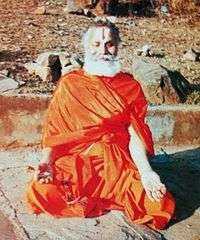Sukhasana

Sukhasana (soo-KAH-sah-nah[1]; Sanskrit: सुखासन; IAST: Sukhāsana), Easy Pose,[2][3][4][5] Decent Pose,[6] or Pleasant Pose[7] is an asana practised in yoga, buddhism and hinduism, similar to sitting in a simple cross-legged position. While opening the hips and lengthening the spine, the asana's relative ease on the knees makes it easier than siddhasana or padmasana for people with physical difficulties. Some schools do not consider it to be as effective for prolonged meditation sessions because it is easy to slump forward while sitting in it. For meditation, it is important that the spine be straight and aligned with the head and neck. But if the practitioner steadies the Sukhasana pose by putting pillows or blankets under the knees to create a steadiness, it may be easier to sit longer in Sukhasana for meditation without slumping forward. An additional blanket or pillow under the buttocks may also be beneficial and steadying.[8] The 20th century Jnana Yoga guru Ramana Maharshi advocated it as suitable for attaining Enlightenment.[9]
Etymology

The name comes from the Sanskrit words Sukha meaning "pleasure",[10] and Asana (आसन, Āsana) meaning "posture" or "seat".[11]
See also
References
- ↑ Budilovsky, Joan; Adamson, Eve (2000). The complete idiot's guide to yoga (2 ed.). Penguin. p. 202. ISBN 978-0-02-863970-3. Retrieved 11 April 2011.
- ↑ "Yoga Journal - Easy Pose". Retrieved 2011-04-11.
- ↑ Satyananda Saraswati (1974). Meditations from the Tantras, with live class transcriptions. Bihar School of Yoga. p. 94. Retrieved 11 April 2011.
- ↑ Institute Of Naturopathy Staff (6 December 2003). Speaking Of Yoga For Health. Sterling Publishers Pvt. Ltd. p. 56. ISBN 978-1-84557-026-2. Retrieved 11 April 2011.
- ↑ Feuerstein, Georg; Payne, Larry (5 April 2010). Yoga For Dummies. For Dummies. p. 200. ISBN 978-0-470-50202-0. Retrieved 11 April 2011.
- ↑ Yardi, M. R.; Bhandarkar Oriental Research Institute (1991). The Bhagavadgītā, as a synthesis. Bhandarkar Oriental Research Institute. p. 130. Retrieved 11 April 2011.
- ↑ Micozzi, Marc S. (2001). Fundamentals of complementary and alternative medicine. Churchill Livingstone. p. 362. ISBN 978-0-443-06576-7. Retrieved 11 April 2011.
- ↑ Rama, Swami, Meditation and its Practice, Himalayan Institute, 1992
- ↑ Maharsi Ramana (1962). The teachings of Bhagavan Sri Ramana Maharshi in his own words. Rider. p. 134. Retrieved 11 April 2011.
- ↑ Joshi, Dr. K S (32 December 1991). Yogic Pranayama: Breathing for Long and Good Health. Orient Paperbacks. p. 45. ISBN 978-81-222-0089-8. Retrieved 11 April 2011.
Sukha means pleasure. Sukhasana is a posture in which one can sit with pleasure, ie, without a feeling of ...
Check date values in:|date=(help) - ↑ Sinha, S.C. (1 June 1996). Dictionary of Philosophy. Anmol Publications PVT. LTD. p. 18. ISBN 978-81-7041-293-9. Retrieved 9 April 2011.
Further reading
- Iyengar, B. K. S. (1 October 2005). Illustrated Light On Yoga. HarperCollins. ISBN 978-81-7223-606-9. Retrieved 9 April 2011.
- Saraswati, Swami Satyananda (1 August 2003). Asana Pranayama Mudra Bandha. Nesma Books India. ISBN 978-81-86336-14-4. Retrieved 9 April 2011.
- Saraswati, Swami Satyananda (January 2004). A Systematic Course in the Ancient Tantric Techniques of Yoga and Kriya. Nesma Books India. ISBN 978-81-85787-08-4. Retrieved 9 April 2011.